Last year we decided that, as a data science focused staffing and recruiting company, it only made sense to look at our own numbers for some insight on the data hiring market. We had noticed some shifts in the requests we were receiving and wanted to understand why—and see if that understanding could help us better serve our clients. So we published our first ambitiously-titled Trends in Data Hiring report after Q2 2021.
With 2021 firmly behind us, we wanted to compare the data from the entire year, but as we got knee deep into those numbers, we realized we needed to recalculate some of our quarterly findings. You can check our previous reports on our blog, but just know that although some data has changed, the overall conclusions are still on par with what we see now.
One quick disclaimer before we jump into the analysis: the data in this report comes solely from jobs, both contract and permanent, that we were tasked with filling in 2021. As such, this does not represent a statistically significant, random sample. However, it does mimic much of what we heard from our clients and other anecdotal sources.
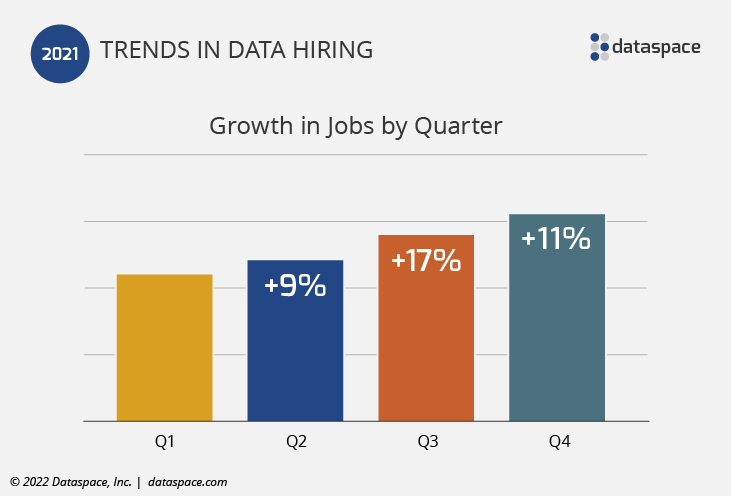
Over the course of 2021, we saw steady growth in data hiring. The chart above shows a solid increase in the number of jobs we were actively working on each quarter.
While our numbers solely reflect our experience in data science hiring, we wouldn’t be surprised if staffing and recruiting companies across the board are experiencing a similar boom. Hiring is strong (…ahem, “cutthroat,”) in pretty much every sector, and unemployment has almost returned to a pre-pandemic low.
So without further ado, let’s dig into some data hiring data!
Who is hiring data talent?
One of the biggest changes we’ve seen at Dataspace in 2021 is a broadening of our client base. In previous years, we primarily worked with enterprise companies in the insurance, automotive, finance, and technology industries, frequently within our region of the Midwest. However, shifts in the market have allowed us to significantly expand our reach. Specifically, we believe there are two noteworthy factors at play:
- The global pandemic inspired a widespread normalization of—and subsequent boom in—remote work.
- The already competitive data hiring market is only getting more intense as businesses of all sizes recognize the value of understanding their data.
Dataspace CEO, Ben Taub, explains the impact to data hiring:
When you look at how things have shifted, it makes sense that more varied companies from across the country would be contacting us for help filling data science related roles. The market conditions mean they are having a really hard time finding candidates, and with everyone suddenly being comfortable with remote work, they’ve started to look outside their area for talent (and help finding that talent).
Industries Hiring Data Talent
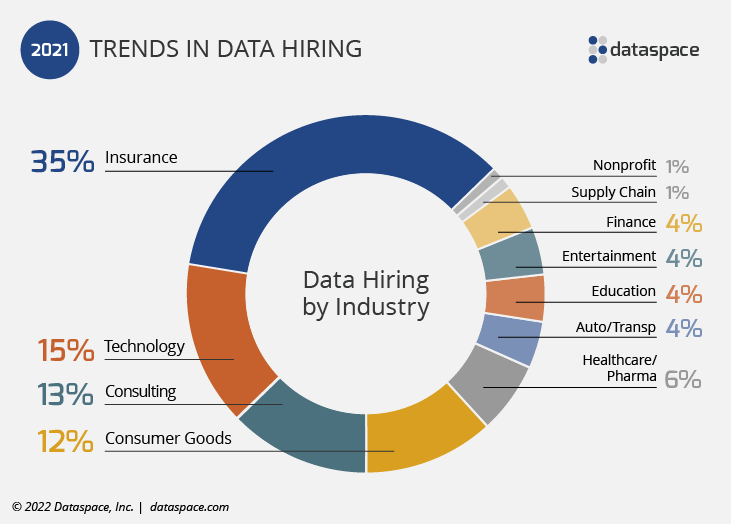
Top 5 Industries Hiring Data Talent in 2021
- Insurance
- Technology
- Consulting
- Consumer Goods
- Healthcare/Pharma
Of the industries we’ve worked with in 2021, It’s logical that insurance and technology would top our list—both rely heavily on data, and both are industries we’ve served in the past. But, interestingly, we’ve seen a lot of growth in consumer-focused industries, such as consumer goods, entertainment, and education.
The key point here is that the need to capitalize data is no longer limited to one or two “data intensive” industries—all industries need to access, interpret, and act on their data. However, traditional data skillsets won’t cut it in today’s world of cloud data platforms, machine learning, and the like. Thus, organizations are seeking new avenues, including contacting us at Dataspace, to find the data science and engineering staff they need to stay competitive.
Size of Businesses Hiring Data Talent

Another change in 2021 is that we’ve seen more interest from smaller businesses and startups. Together they comprise more than a third of our jobs for the year! Ben has some thoughts on why:
The tools to store, analyze, and understand data are no longer toys reserved for the big kids. With almost every aspect of business handled by one SaaS application or another, the data is there for the taking, even for business tots—and the value it holds is priceless! Companies of all sizes recognize that harnessing their data is a great way to drive great business.
In addition, data science has moved from being an enhancer of traditional businesses to the actual product of many startups. In one way or another, data science is what many of our startup clients deliver. It may be in the form of improved healthcare, better banking services, or even new ways to provide entertainment, but at their core, these clients’ products are the data science algorithms and their results.
I’m reminded of how, a few years ago, it was in vogue to say that your company wasn’t actually in business X, it was a technology company that happened to deliver X. For example, Dominos wasn’t a pizza company, it was a technology company that applied that technology to pizza. Well, in many ways, many of our startup clients aren’t healthcare and finance companies, they’re data science companies that use that technology to deliver better healthcare and financial services.
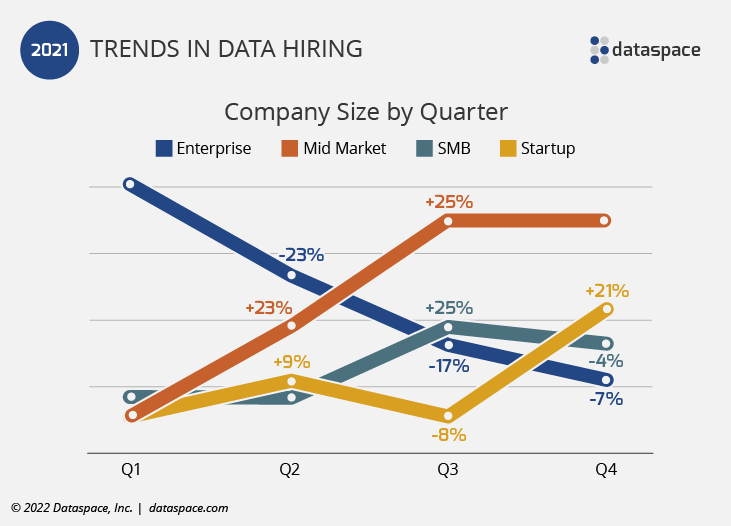
In 2020, enterprise companies were responsible for most of our hiring efforts. But as the global pandemic let up a bit in mid 2021, there was a big shift in the size of companies contacting us for help finding data talent.
By the end of 2020, enterprise businesses were back to, and even surpassing, normal hiring levels because they had the resources to do so. But as economic confidence grew stronger, mid-tier and smaller businesses also felt comfortable reinvesting in growth, which translates to more hiring.
Location of Business Hiring Data
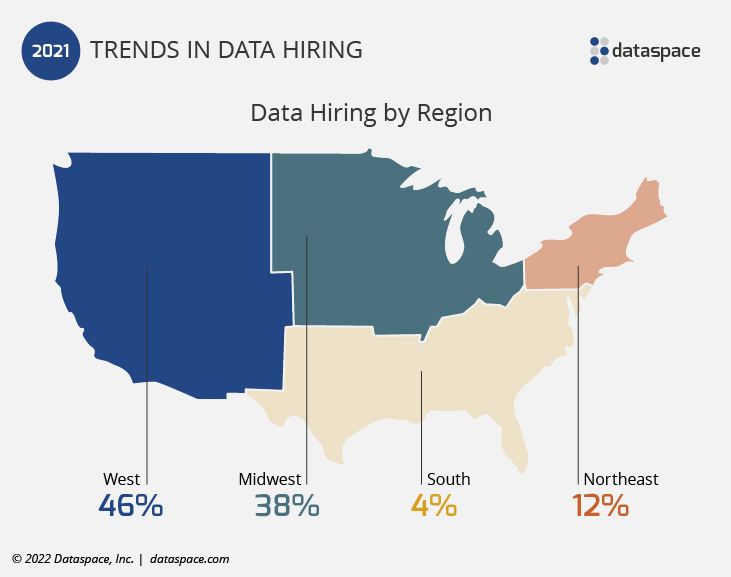
As a Michigan-based company, not surprising that a good share of our clients hails from the Midwest. But when it comes to data hiring outside our region, our work with companies out west grew by 41% over the course of the year. Ben explains:
It makes a lot of sense that tech companies and startups would be among the earliest to resume hiring data talent, and it’s no secret that many startups come out of West Coast tech hubs like San Francisco and Seattle. We also saw tech companies and startups add to our growth in other regions as well, but there’s simply just more of them out West.
What types of data talent do organizations need?
The fact that data science professionals are in high demand is nothing new. But what those jobs look like has changed a lot over the past few decades. In this section of our look at data hiring, we’ll break down the characteristics of the data jobs we worked on in 2021, and share our thoughts on what this means for the field.
Data Job Specializations
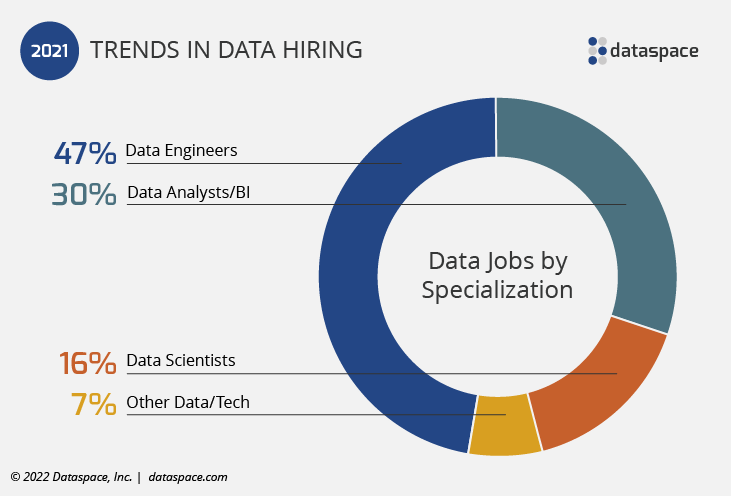
The field of data science is comprised of hundreds of similar-sounding job titles, but they can basically be categorized three specialized areas:
- Data Analysts collect, visualize, and interpret data to inform business decisions. Business intelligence, which is the predecessor of modern data science, would fall under this category. This vital function generally focuses on descriptive analytics, detailing what has happened and how to interpret it.
- Data Engineers are the experts who build the systems that store and integrate massive amounts of raw data, as well as the pipelines that allow other data professionals to put that data to use.
- Data Scientists are the experts who design the complex algorithms and predictive models needed to attain the desired insights. Thus, they are generally more focused on predicting the future based on data from the past. As opposed to data analysts, data scientists usually have much stronger foundations in statistics.
As we’ve noted in past hiring reports (Q2 2021 and Q3 2021), data scientist has been predicted to be the highest growth profession in technology. But our in-the-trenches experience begs to differ. It’s the data engineers who have regularly been most in demand in data hiring. Ben shares his thoughts on why:
If you think about it, it’s pretty clear why the demand for data engineers remains so high, even as the need for data scientists grows—data engineers build the systems required by data scientists. So for every data scientist, and for most data analysts, you may need multiple data engineers with further specializations to get the work done. And because data engineering is so critical, we find businesses are willing to pay a premium for strong data engineers.

In 2021, we’ve also noticed a steady increase in the demand for data analysts and business intelligence experts. Requests for analysts grew 21% over the year, and make up nearly a third of the jobs we worked on!
You can almost think of analytics and BI as data science, light. I think we are seeing growth here because startups and smaller businesses are just starting to build out their data teams and don’t yet have the needs of a fully data-driven company. If you have a limited budget, but want to make better business decisions, analytics is a great place to start. The time for pure data science may be a year or two down the road, however, once you’ve gained confidence in analytics and assembling your data for analysis.
Data Job Employment Types
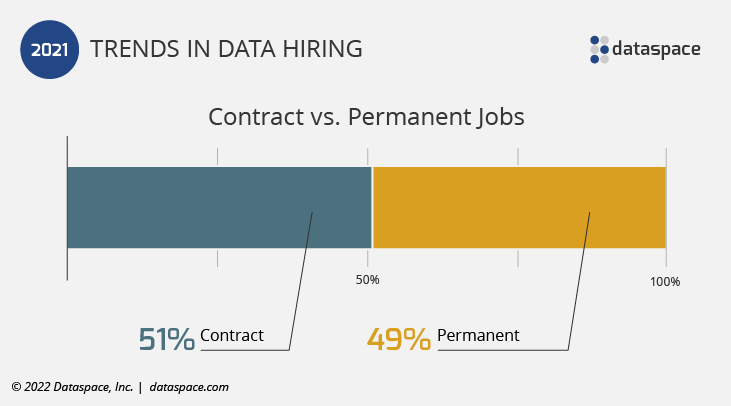
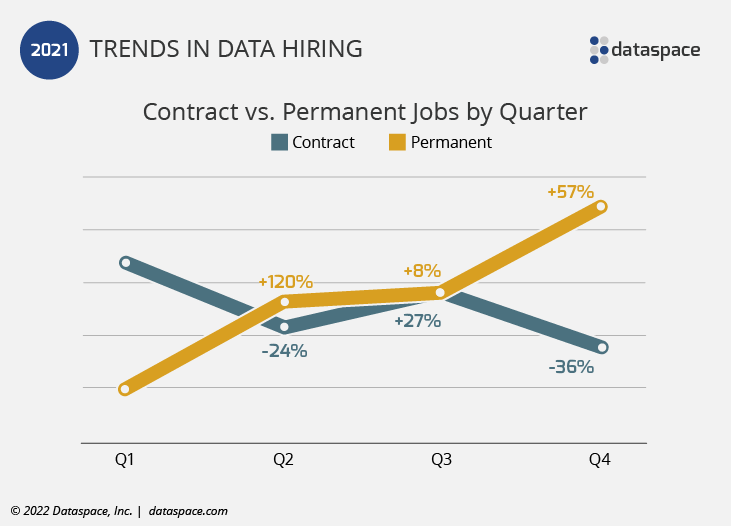
Over the past decade, Dataspace had carved out a niche sourcing high-quality data contractors to enterprise-level companies that needed to scale quickly for a project. And while the demand for temporary data talent has remained relatively stable for us, we’ve seen a sharp increase in requests for help filling permanent data science roles. By the end of the year, nearly half of the jobs we worked on were permanent placement. Why the increase? Katie Magill, Dataspace’s Lead Recruiter, offers her thoughts:
This shows just how competitive the data hiring market is. More companies are contacting us because they are having such a hard time filling these permanent roles themselves. They’re looking for help they didn’t need before, when candidates were easier to find.
For us, contracting and permanent hire are basically like two sides of the same coin. Ultimately, the candidate pools may be different, but the techniques we use to recognize and screen talent—our “secret sauce”—are very similar.
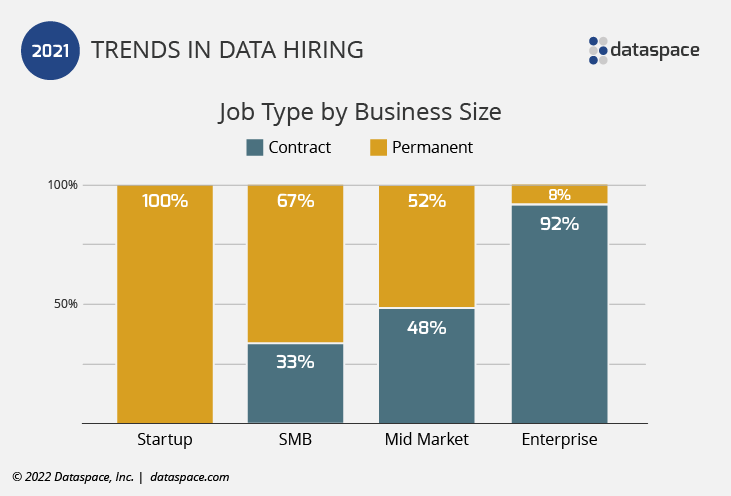
If we look a little deeper into who is hiring permanently, there’s a striking difference depending on the company size. Enterprise businesses drive almost all of our contract hiring. Why? Ben shares his thoughts:
There is a bit of a premium for contract workers, and these huge companies have the resources to ramp data teams up or down, when they need it. It’s a luxury smaller companies just don’t have. Also, the goal of most smaller companies is to become bigger. So, not only do you need tech and data science talent to build out your capabilities and infrastructure, you also need to keep that talent on board to enhance and grow the data team.
Our numbers seem to support this—about two-thirds of contract roles at mid and enterprise level companies are for data engineers, often junior level with highly-specialized skills.
Location of Work for Data Jobs
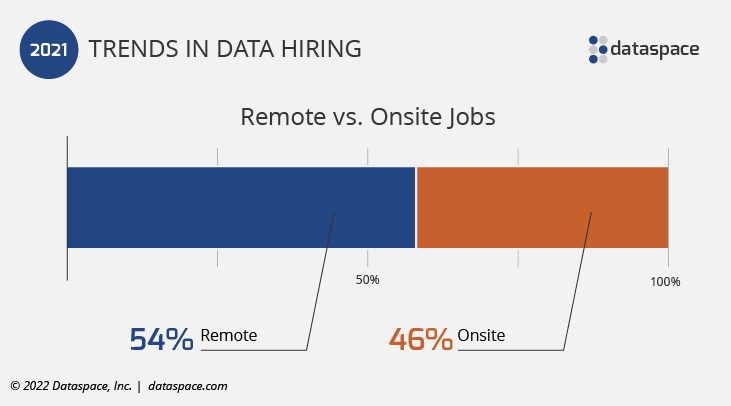
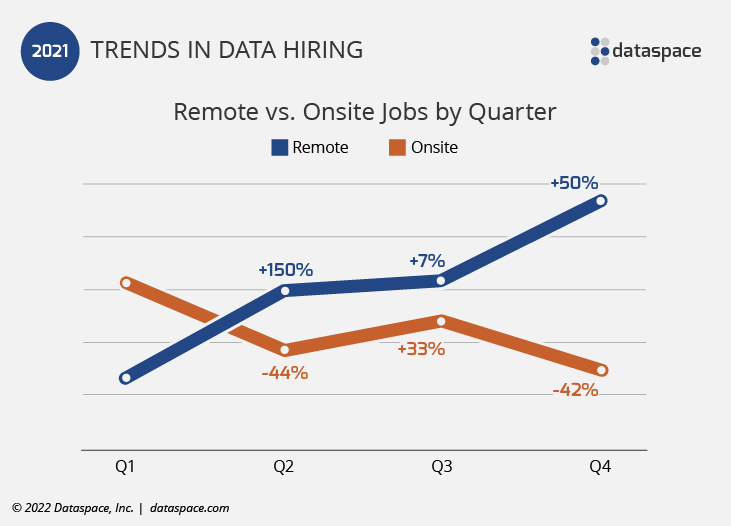
If there is one undeniable trend that may have cemented itself in the modern workplace, it’s the ability to work remotely. While we’ve had the tools to do so for many years, it took a global pandemic to make it commonplace. And there are lots of good reasons to continue to offer remote work post COVID. Ben explains:
Above all, employees like remote work. More and more good candidates are demanding the option and even turning down great jobs if they are onsite only. And it’s easy to see why—benefits like greater flexibility, saving commute time, and the ability to live where you really want to be. But there are some very compelling benefits for employers as well. One thing we like is that it really expands your candidate pool when you are hiring for a tough-to-fill data position. Especially if you’re requiring some really esoteric technical skills. In fact, the number one thing you can do to attract strong candidates (assuming you’re offering competitive compensation and interesting work) is to accommodate remote candidates. (The second, which people are slightly more wary of, is to be open to sponsoring immigrant work visas.)
Most Requested Data Skills
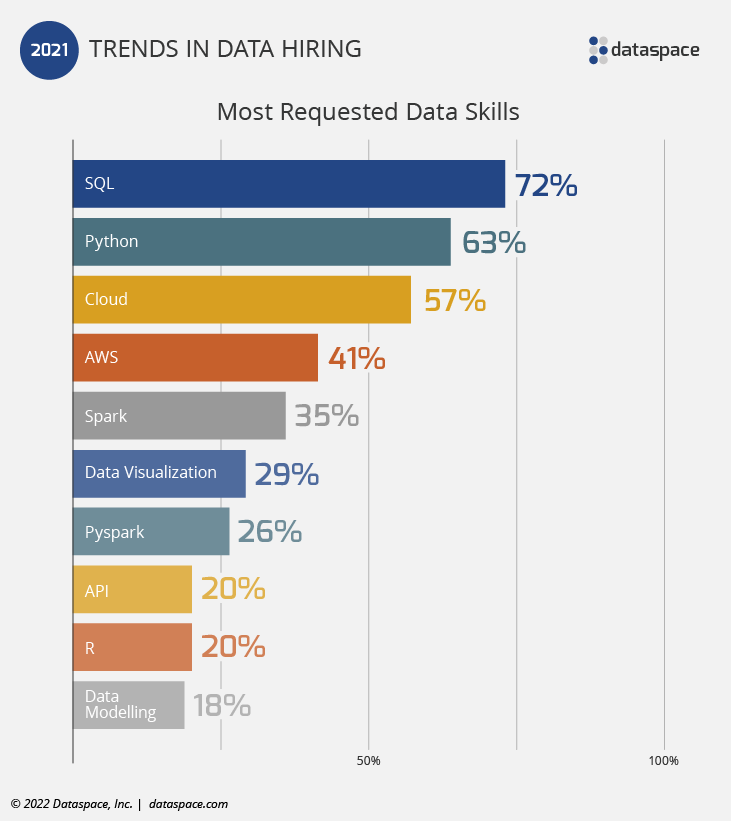
Top 5 Requested Data Skills in 2021
- SQL
- Python
- Cloud
- AWS
- Spark
So what are the more in-demand data science skills for 2021? We had to make some adjustments once we had all of our final numbersin, but the top five skills are really hard to dispute. Ben explains the value of each:
- Knowing SQL is basically table stakes to get into the data game. While different roles may require different levels of skill, it’s really no surprise that 72% of the jobs we worked on required it. In fact it’s probably implicitly required in nearly all of them.
- Python is nearly as ubiquitous because it’s been around a long time and it’s one of the most popular programming languages in the world. It’s really become the preferred language for both data science and data engineering.
- If you work in data, you’re going to want to be sure cloud experience is part of your skillset. Data is done in the cloud, and any that isn’t will be very soon. It’s cheaper, faster, far more flexible, and doesn’t require any on-prem real estate.
- And, as businesses move their data to the cloud, they continue to request Amazon Web Services more than any other host. AWS is the most popular cloud platform because it’s been around longer and offers more capabilities than its competitors. (However, all three major cloud platforms, AWS, Microsoft Azure, and Google Cloud Platform, offer roughly analogous services. Therefore, given the tightness in the skills market, many employers are willing to hire people with skills in any of the three, and see those skills as easily transferable.)
- Businesses need to make sense of massive amounts of data. Spark has become such a highly-requested skill because it’s used to make all that data available for rapid analysis. I will note, however, that lately we are starting to see less demand for pure Spark as organizations more toward technologies built on things like Spark, such as Snowflake and Databricks.
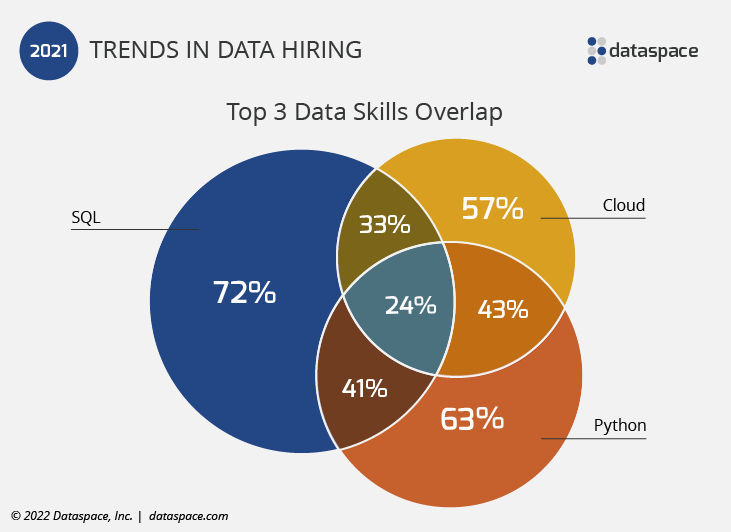
Of all the jobs we worked on last year, fewer than 3% did not require at least one of our top three requests skills, SQL, Python, or cloud experience, but nearly a quarter required all three!
There’s a lot of overlap in these three skills because they really are the foundations of working with data nowadays. Get competent in these, and you’ve got the makings of a strong, in demand career.
What does this mean for data hiring in 2022?
Because of the extreme economic variability of the past two years, it’s hard to know if 2021 will be a reliable indicator of true trends in data hiring, or if it’s a complete outlier. We do feel pretty confident in making a few predictions, because they track with our experiences over the past few years:
- The job market for data science-related careers is strong, and will continue to grow, as SMBs add data teams to their workforce.
- Data engineers will continue to be in greater demand than data scientists—they are the force supplying the data to data scientists.
- Cloud computing is the future of all data work—demand for the skill is high, but it will soon be ubiquitous.
Ben sums it up:
2021 was a big growth year for us. In fact, we doubled our staff size and started working on some extremely rewarding requirements with some very cool clients. 2022 looks to promise more of the same. It’s been very gratifying, as the data field has exploded, to be able to take the analytics technical experience we’ve developed over the past 28 years and apply it to some very interesting, and meaningful projects.
Are you having a hard time finding data talent with the skills you need? Contact us to learn how we can help.
Are you looking for your move to advance our data career? Check out our job board for our current openings.

